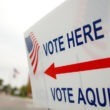There are two sides in the ongoing political and technical scrap over efforts to reform the voting process, a move begun after the 2000 election scandal in Florida. The Florida election gave—or alleged—a 537-vote edge to George W. Bush over former Vice President Al Gore.
Remember? With the help of the 5-to-4 Supreme Court decision that blocked a ballot recount there, and then the screwy procedure of the Electoral College (which we will be exploring, and deploring, soon), Bush became “the accidental president.”
In this election year that accident may be less likely. Slowly emerging reforms are focused on electronic, touch-screen voting machines—DREs, for “direct recording electronic” gadgets—whose vulnerability to technical failure and/or partisan tinkering has become an under-reported campaign issue.
(That’s not the only vacuum in news coverage. A new analysis of print and broadcast journalism finds them both in retreat. See FYI.)
This year some 30 percent of November 2 voters nationwide—all of them in Maryland and Georgia—will be gingerly touching spots on small computer screens that seem to record their votes, and that offer them an on-screen “review” of what they did.
There are criticisms of this post-Florida change from punch card ballots—the ones that made “hanging chads” famous—and from old-fashioned lever machines. They range from evidence that the new electronic voting systems break down, to other—even scarier—evidence that they can be “hacked” into and the results manipulated for political reasons.
We are already getting results of these possibilities. Last year, in a local election in Boone County, IN, an electronic system recorded 144,000 votes in a jurisdiction with 19,000 registered voters.
As for the recent primary voting, whether voters were confused or scared off by tricky voting machines or their votes were electronically erased by faulty miscounts, the recorded turnout this year has been low overall.
The Committee for the Study of the American Electorate (CSAE), a nonpartisan research group, says that only 14.5 million voters, 7.2 percent of the 200,483,000 eligible, participated in this year’s primaries through Super Tuesday on March 2. The turnout by Democrats was 11.4 percent, versus 6.6 percent by Republicans.
The CSAE says “the religion of civic duty,” which brought larger voter turnouts in the 1960s and 1970s, “has been severely undermined.” But it predicts a higher turnout of 58 percent or more in November, a growth “that will not benefit the president.”
A MOCKERY—Not all agree that the decline of civic duty and the low voter turnouts have been the result of spooky voting machines, but there is no dispute about the Bush administration’s lack of interest in finding out if they have.
Congress responded to the Florida trauma in 2000 by passing the Help America Vote Act (HAVA), creating a new federal Election Assistance Commission to administer what was supposed to be an $800 million program to help the states quickly fill their voting vacuums.
But the Bush White House didn’t get around to appointing the election helpers until nearly a year after the HAVA deadline, and then gave it only $2 million of the $10 million it was due. The Election Assistance Commission has too little money and too skeletal a staff to distribute much of the badly needed reform money to the states. For their part, state governments rely on county governments to train and supervise polling place workers and to tally the local voting returns. The whole process is weak.
For electronic voting machine accuracy the most immediate reform is insisting upon having a “paper trail printout.” That is a printed paper record, the size of a cash register receipt, of how Citizen X voted. It is ejected into a sealed, windowed container in which the voter can scan what he or she did and ask for a re-vote if there was a mistake. When the voter removes the electronic identification card, issued by polling place workers, the printout is saved and goes into a concealed bin for a recount, if needed.
Without that printed record, though, Citizen X has no reasonable assurance that all went as planned. Fortune magazine recently called paperless electronic voting the “worst technology” of 2003. And Representative Robert Wexler (D-FL), has filed a federal lawsuit requesting a court order to require the Florida counties that have no paper trail printouts to install the equipment by November.
Some state election officials have resisted paper printouts. David Heller, the Secretary of State of Nevada, has said that “I clearly believe that there are certain people within the election process who don’t want that scrutiny on how elections run.”
The supposedly non-partisan role of the 50 secretaries of state who oversee and control each state’s election process began to get some headline attention when Florida’s vote-fiddling secretary of state, Katherine Harris—now in Washington as a Republican member of the House—was disclosed to be the co-chairman of the 2000 Bush-Cheney election campaign in the Sunshine State.
Now we learn that in Michigan and Missouri the secretaries of state have top spots in their state’s 2004 Bush-Cheney campaigns. Decisions by these partisan office holders can sometimes control who wins a close election.
They can also influence the selection of voting machine suppliers, some of which are involved in partisan politics.
Among the loudest critics of voting machine company misconduct is Bev Harris, who runs Black Box Voting, an activist group that has raised many troubling questions about Diebold Election Systems, an industry leader and the well-paid supplier of the “AcuVote” electronic machines used in 37 states.
Diebold’s CEO, Walden O’Dell, is such a big-time Republican fund-raiser in Ohio that he has been invited to the Bush ranch in Crawford, TX, for thanks. He sent fund-raising letters to other fat cats saying that he is “committed to helping Ohio deliver its electoral votes to the president”—meaning Bush.
Bev Harris’ recent book, Black Box Voting—Ballot Tampering in the 21st Century, is available for $19.95 by calling (425) 228-7131 or at her website, www.blackboxvoting.com. Or it can be ordered at www.amazon.com.
THERE’S MORE—Ed Davis is the vice president for policy and research at Common Cause, a decades old, nonpartisan reform group based in Washington. Davis is knowledgeable about the issue of electoral reform, and he has written the following informative essay about it:
The act of voting is the cornerstone of our democracy. Americans must have confidence that their vote will be counted fairly and accurately. The 2000 presidential election exposed many of the shortcomings in our nation’s elections and damaged voters’ faith in how we cast and count votes. Since then, Congress has passed significant, though delayed, reforms in the Help America Vote Act (HAVA) and some state and local governments have taken steps to correct the longstanding problems in our nation’s voting system.
Common Cause shares many of the concerns of a growing number of Americans about the reliability and security of new touch-screen voting machines.
We also share the concerns of those who have worked for many years to ensure that all Americans have the right to vote, have equal access to voting and have the right to vote in private. But we believe that no one’s right to vote has meaning if the voters cannot be reasonably assured that their votes were counted as cast.
Common Cause believes that the ability to verify one’s vote and have a record of each vote as cast must be an integral part of voting equipment. It is important for the accuracy of vote counting and for Americans’ long-term trust in elections.
We do not believe that current touch screen technology allows the voter to verify his or her vote in a meaningful manner. The voter must have faith that the internal software is correctly tallying the vote, and there is currently no way to verify the vote independent of that software.
We believe it is critical at this point to provide a voter-verifiable paper audit trail as one of the essential requirements of voting systems.
While we recognize the demonstrable problems with paper-based voting systems and support efforts to develop new technology for future systems, including all-electronic verification systems, we remain convinced that, for now, a paper-based verification system is the best alternative.
We know that touch-screen voting machines offer numerous benefits: faster counting of votes, accessibility for physically handicapped voters, and flexibility for different languages and different ballot types. In terms of error rates, touch-screen voting machines, with the assurance of a paper trail, can be the most effective method for casting and counting votes.
We challenge the voting machine industry, election officials and the technology community to develop a voting system that will retain the many benefits of touch-screen voting, but will not require voters to rely on simple faith in software that their vote will be counted as they cast it.
OTHER PROBLEMS—New technology is not the whole solution. Voting machines are only one part of the voting system. Voter education, poll worker training, especially in regard to fair and equal treatment of voters, provisional ballots, the elimination of unnecessary voter identification requirements, polling place accessibility, and collection of data on voters’ actual experience in the polling place are all important priorities.
Voting machine manufacturers and many election officials have rushed to develop and put in place touch-screen machines without sufficient regard to voters’ confidence in the machines and without regard to basic principles of transparency and accountability. A business-as-usual manner, careless procedures, and overtly partisan activity by some vendor executives have exacerbated voters’ alarm about the new machines.
The companies that produce equipment for elections must be held to a far higher standard of accountability and transparency. State and local election officials must be far more vigilant in their oversight of the vendors. The government, not the vendors, must be in control of our system of voting.
Vendors should adhere to strict nonpartisan policies and practices. Companies producing voting equipment must understand that they are operating in the public arena, and that their products are a critical element in the democratic process. No more executives saying they will “deliver the votes” for a candidate, as the head of one company did in his role as fund-raiser.
There must be a competitive and open contracting process for purchase of voting machines. Too often, at the state and local levels, the business of voting equipment has been conducted behind closed doors and with limited competition.
This is the public’s business, not a private negotiation between election officials and voting machine vendors. Additionally, we support a proposal by People for the American Way that the states establish broad-based citizens panels to advise officials throughout the process of adopting new voting systems.
There must be strict conflict-of-interest codes for election officials and vendors. Common Cause has worked to end the cozy relationship between elected officials and special interests. No more vendor-sponsored outings bringing together those purchasing voting machines and those selling the machines.
Testing of machines should be done publicly and by a truly independent body. Testing should be done at every step of the process, including random testing of machines on Election Day. While we believe that a paper trail will provide an added level of security and confidence, it is also essential that election officials adhere to strict standards of independence in testing the technology they are purchasing and that testing be done at every step of the process.
FUTURE REFORM—The time for reform is not over. Our system of voting should be an ongoing national priority. Congress must not treat the Help America Vote Act as a one-time reform. HAVA should be a precedent for federal funding and assistance to state and local governments that will make our system of voting the best it can be.
We will continue to work at the state and local levels to ensure that HAVA is implemented fairly and fully and to fight against efforts to put up new barriers to voting.
Congress and President Bush took far too long to appoint and confirm commissioners to the Election Assistance Commission, the federal agency charged under HAVA with dispensing funding and developing new standards for voting machines. The commission recently held its first meeting and announced plans to hold hearings on the electronic voting machine issue. Common Cause will be closely watching to ensure that the commission operates in an open and accountable manner and that a wide range of opinions and expertise are included in its proceedings.
Unfortunately, November 2004 could be “déjà vu all over again.” According to a recent report by the Election Reform Information Project, “those who expect that all of the ills revealed in the 2000 election will be cured by November 2004 will most certainly be surprised.” We hope that all goes well on Election Day, but we know that whatever happens much work will remain to improve many aspects of our nation’s system of voting.
Congress and President Bush must commit themselves to funding HAVA fully and to provide additional funding if that becomes necessary. Congress and the president should make this a long-term federal commitment. There are few more fundamentally important functions of the government in our democracy than providing a fair, secure, convenient and accessible voting system. Such a system will build confidence with voters and may begin to restore much of the public’s loss of trust in our democracy.





0 Comments